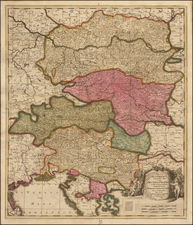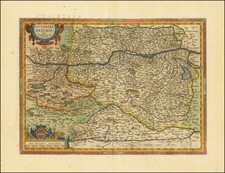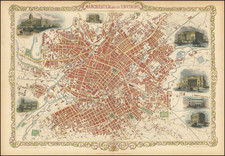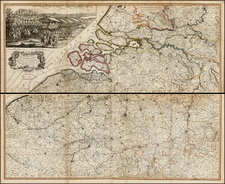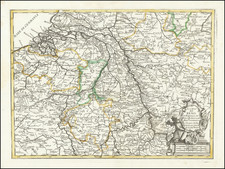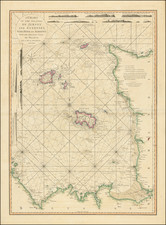The First Modern Map of Northern & Central Europe to Appear in Print - Tony Campbell, Curator of Maps at the British Library.
Attractive example of Hartmann Schedel's important 1493 map of Northern and Central Europe, from the Latin edition of Schedel's Liber Chronicum, perhaps the single most influential secular illustrated book of the 15th century.
The map is the second-earliest depiction of Scandinavia and the Baltic Coast in a printed map and the earliest modern mapping of the region around Germany (preceded by the ancient maps of the region to appear in Ptolemaic texts). It is also the earliest obtainable map to focus on central Europe, preceded (possibly) by the circa 1492 Rosselli map (known in two examples) and the famous Eystatt map (no longer extant in a pre-1530 edition; discussed below).
The map was engraved was Hieronymus Munzer, the physician for the city of Nuremberg who had been invited to contribute to the Chronicles on the basis of his wide travels through Europe. To accompany his geographical descriptions, Munzer constructed this map that was bound in at the end of the Chronicles. As a cartographic basis, he used the now-lost manuscript maps of Nicholas of Cusa, a mid-15th-century cardinal whose maps were thought to be constructed during the period 1439 and 1454.
Munzer's creation is one of the important cartographic innovations of the 15th century, being among the earliest appearances of any non-Ptolemaic mapping in print and showing a wide swath of Europe. The map itself extends from Ireland, Iceland, and the British Isles in the northwest through to Scandinavia in the northeast. In the southeast, an oversized Black Sea is visible, and the map extends just into Italy in the southwest. The map retains some cartographic errors leftover from earlier manuscripts, such as the separate entrances of the Meuse and the Rhine into the North Sea. Munzer was evidently aware that they, in fact, flowed separately, as he correctly describes the Meuse as draining in the Rhine-Meuse delta in his geographic description on the verso.
Cartographic Sources
Munzer used a compendium of sources to create this map. In northern Europe, he directly followed the Zamoyski codex, which was also used as the source for the 1482 Ulm Ptolemy map of Scandinavia. Further south, the exact lineage of the cartography is less certain. It has been proposed that some of the cartography draws from Rosselli's map of Central Europe, as it is known that Schedel owned a complete copy of Rosselli's five maps, but the dating of these maps are uncertain. The geography on Rosselli's world map suggests a date of circa 1492, but it is far from certain whether the information on Rosselli's printed map predates Schedel.
The map bears a much stronger affinity in its geography to what is known about the Nicholas of Cusa maps. Cusa's output, as mentioned above, was a series of manuscript maps from the period circa 1450 that are now lost, but known through their derivatives and descriptions. As such, Cusa is often referred to as the main source for the southern portion of this map.
It is interesting to compare this to the only printed edition of Cusa's work, termed the "Eischtätt map," with which it bears many similarities. This map is one of the most confounding to appear in the 15th century. It has been suggested that it was originally engraved as a supplement to the 1478 Rome Ptolemy given similarities in the engraving style, but its earliest mention comes in a 1518 text. Furthermore, only two editions are known, the latter of which was published circa 1530. The first edition, which was undated, was known in only one copy and was destroyed in Munich in 1944. The second edition is known in eight copies.
Schedel's Nuremberg Chronicles
Hartmann Schedel's Liber Chronicarum: Das Buch der Croniken und Geschichten (loosely translated as World Chronicle, but popularly referred to as the Nuremberg Chronicle, based upon the city of its publication), was the first secular book to include the style of lavish illustrations previously reserved for Bibles and other liturgical works. The work was intended as a history of the World, from Creation to 1493, with a final section devoted to the anticipated Last Days of the World. It is without question the most important illustrated secular work of the 15th Century and its importance rivals the early printed editions of Ptolemy's Geographia and Bernard von Breydenbach's Perengrinatio in Terram Sanctam in terms of its importance in the development and dissemination of illustrated books in the 15th Century. Published in Nuremberg by Anton Koberger, the book was printed in Latin and 5 months later in German (translated by George Alt), and enjoyed immense commercial success. A reduced size version of the book was published in 1497 in Augsburg by Johann Schonsperger. The illustration for Venice is adapted from the larger illustration of Venice in Breydenbach's Peregrinatio, which was illustrated by Dutch artist Erhard Reuwich, who was working in Mainz in the 1480s. Schedel's view of Florence is one of the earliest obtainable views of the City and realistically the only large format 15th Century illustration available to collectors. The view is an adaptation of Francesco Rosselli's now lost six-sheet engraving of Florence, which is believed to have been engraved sometime between 1471 and 1482, known only through a single woodcut copy in the Kupferstichkabinett of Berlin. Rosselli is perhaps best known as the cartographer responsible for the Contarini-Rosselli World Map of 1506 (the first map to depict America, based upon information derived from Columbus) and his world map of 1508, the first depiction of the World in an Oval Projection, which includes a depiction of the Southern Continent which may have been the influence for the world maps of Piri Reis (1513), Lopo Homem (1519) and Juan Vespucci (1524).
Hartmann Schedel was a prominent physician and writer, who amassed one of the largest private book collections of the 15th century. Schedel's work is illustrated by over 1800 woodcut images by Michael Wohlgemut (1434-1519) and his stepson Wilhelm Pleydenwurff (1460-1494). Wohlgemut, an important painter and xylographer, is perhaps best known as having been an early teacher of Albrecht Durer, who apprenticed in Wohlgemut's workshop from 1486 to 1489. It is believed that Durer was involved in the production of several of the illustrations in Schedel's Liber Chronicarum, as work on the illustrations commenced during the period when Durer was apprenticing with Wohlegut and a study of several of the illustrations suggests they may have been drawn by Durer, who would have prepared the drawings used as forms for the craftsmen who cut the woodblocks.
While the majority of the illustrations in the book depict the various saints, royalty, nobles and clergyman of the period, the work is perhaps best known for the large format views of a number of the major European cities, including Rome, Venice, Paris, Vienna, Florence, Genoa, Saltzburg, Crakow, Breslau, Budapest, Prague, and major cities in the Middle East, including Jerusalem, Alexandria, Constantinople, as well as a number of cities in what would become the German Empire. The work also included a magnificent double page map of the World, a large map of Europe and several famous illustrations, including the "Dance of Death," and scenes from the Creation and the Last Judgement. While many of the double-page city views are less than accurate illustrations of the cities as they existed at the end of the 15th century, the illustrations are of great importance in the iconographic history of each of the cities depicted. Some of the double-page views were also apparently offered separately for sale, including some which had been colored prior to sale.
Schedel's World map is based upon Ptolemy, omitting Scandinavia, southern Africa and the Far East, and depicting the Indian Ocean as landlocked. The depiction of the World is surrounded by the figures of Shem, Japhet and Ham, and the sons of Noah, who re-populated the Earth after the Flood. On the left, printed from a separate block, are pictures of various mythical creatures, based upon classical and early mediaeval travellers' accounts, including "a six-armed man, possibly based on a file of Hindu dancers so aligned that the front figure appears to have multiple arms; a six-fingered man, a centaur, a four-eyed man from a coastal tribe in Ethiopia; a dog-headed man from the Simien Mountains, a cyclops, one of those men whose heads grow beneath their shoulders, one of the crook-legged men who live in the desert and slide along instead of walking; a strange hermaphrodite, a man with one giant foot only (stated by Solinus to be used a parasol but more likely an unfortunate sufferer from elephantiasis), a man with a huge underlip (doubtless seen in Africa), a man with waist-length hanging ears, and other frightening and fanciful creatures of a world beyond." The World map also includes a large island off the west coast of Africa, which may relate to the account of Martin Behaim's voyage to the region, which is referenced by Schedel in the text.
In 1552, Schedel's grandson, Melchior Schedel, sold about 370 manuscripts and 600 printed works from Hartmann Schedel's library to Johann Jakob Fugger. Fugger later sold his library to Duke Albert V of Bavaria in 1571. This library, one of the largest formed by an individual in the 15th century, is now mostly preserved in the Bayerische Staasbibliothek in Munich. Among the surviving portions of Schedel's library are the records for the publication of the work, including Schedel's contract with Koberger for the publication of the work and the financing of the work by Sebald Schreyer and Sebastian Kammermeister, as well as the contracts with Wohlgemut and Pleydenwurff for the original artworks and engravings. The collection also includes the original manuscript copies of the work in Latin and German.
Hartmann Schedel (1440-1514) was a physician, book collector, and writer whose most famous work, the Liber Chronicarum (Nuremberg Chronicle), included some of the first printed views of many cities in Europe and across the world.
Schedel was born and died in Nuremberg, but he also traveled for his education. From 1456 to 1463 he lived in Leipzig, where he attended the University of Leipzig and earned his MA. From there he went to Padua, where he earned a Doctor of Medicine in 1466. After university, he worked for a time in Nördlingen and then returned to Nuremberg. In 1482 he was elected a member of the Great Council of Nuremberg.
The Chronicle was published in 1493. Besides this major work, one of Schedel’s most enduring legacies is his magnificent manuscript and printed book collection, one of the largest of the fifteenth century. In 1552, Schedel's grandson, Melchior Schedel, sold about 370 manuscripts and 600 printed works from Hartmann Schedel's library to Johann Jakob Fugger. Fugger later sold his library to Duke Albert V of Bavaria in 1571. This library is now mostly preserved in the Bayerische Staasbibliothek in Munich.
Among the surviving portions of Schedel's library are the records for the publication of the Chronicle, including Schedel's contract with Anton Koberger for the publication of the work and the financing of the work by Sebald Schreyer and Sebastian Kammermeister, as well as the contracts with Wohlgemut and Pleydenwurff for the original artworks and engravings. The collection also includes original manuscript copies of the work in Latin and German.









